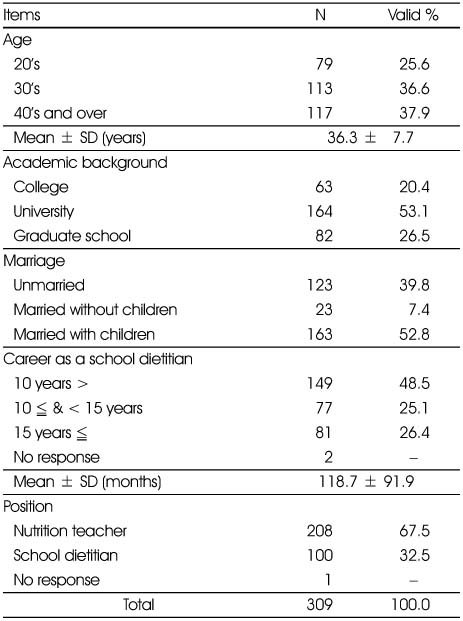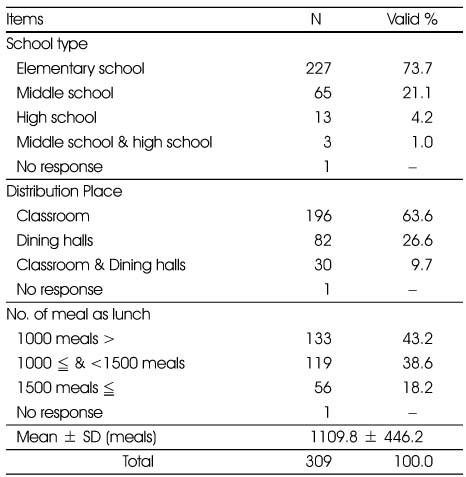Articles
- Page Path
- HOME > Korean J Community Nutr > Volume 16(5); 2011 > Article
-
Original Article
- The Effects of Individual Emotional Characteristics on Emotional Labor of School Dietitians
- Woo-Jong Cho, Ilsun Yang, Hang-Sok Choi, Hae-Young Lee
-
Korean Journal of Community Nutrition 2011;16(5):592-601.
DOI: https://doi.org/10.5720/kjcn.2011.16.5.592
Published online: October 31, 2011
Yeonga Elementary School, Seoul, Korea.
1Department of Food and Nutrition, Yonsei University, Seoul, Korea.
2Department of Business Administration, Dongduk Women's University, Seoul, Korea.
3Department of Food and Nutrition, Sangji University, Wonju, Korea.
- Corresponding author: Hae-Young Lee, Department of Food and Nutrition, Sangji University, 660 Woosan-dong, Wonju 220-702, Korea. Tel: (033) 730-0492 , Fax: (033) 738-7740, hy1317@sangji.ac.kr
Copyright © 2011 The Korean Society of Community Nutrition
- 1,081 Views
- 1 Download
- 3 Crossref
Figure & Data
REFERENCES
Citations

- Contribution of Emotional Labor and Organizational Commitment to Turnover Intention and Customer Orientation of School Foodservice Dietitian in the Busan Area
Kyung-A Lee, Eun-Soon Lyu
Korean Journal of Food & Cookery Science.2017; 33(1): 104. CrossRef - Study on Relations among Emotional Labor, Burnout, Engagement and Customer Orientation of High School Foodservice Employees in Busan Area
Kyung-A Lee, Eun-Soon Lyu
Korean journal of food and cookery science.2015; 31(3): 370. CrossRef - The Effects of Emotional Labor on Emotional Exhaustion of School Dietitians : Comparison on Level of Self-efficacy
Hae-Young Lee
Korean journal of food and cookery science.2014; 30(1): 84. CrossRef
Demographic characteristics of respondents
School and foodservice characteristics of respondents
Reliability and validity on individual emotional characteristics
1) Likert-type 5 point scale : 1 - strongly disagree / 5 - strongly agree
2) Variance %, Total variance % = 65.685%
Individual emotional characteristics by characteristics of respondents
1) Mean ± SD, Likert-type 5 point scale : 1-strongly disagree / 5-strongly agree
*: p < 0.05, **: p < 0.01, ***: p < 0.001, ab: Tukey multiple comparison
Reliability and validity on emotional labor
1) Likert-type 5 point scale : 1-strongly disagree / 5-strongly agree, 2) Variance %, Total variance %=75.650%
Emotional labor by characteristics of respondents
1) Frequency of emotional displaty, 2) Intensity and variety of emotional display, 3) Surface acting, 4) Deep acting, 5) Mean ± SD, Likert-type 5 point scale : 1-strongly disagree / 5-strongly agree
*: p < 0.05, **: p < 0.01, ab: Tukey multiple comparison
Correlation analysis of individual emotional characteristics and emotional labor
1) Correlation coefficient
*: p < 0.05, **: p < 0.01, ***: p < 0.001
Regression of individual emotional characteristics on emotional labor
1) R2 = 0.066 adjusted R2 = 0.063 F = 21.644***
2) R2 = 0.044 adjusted R2 = 0.038 F = 7.043**
3) R2 = 0.030 adjusted R2 = 0.027 F = 9.435**
*: p < 0.05, **: p < 0.01 ***: p < 0.001
1) Likert-type 5 point scale : 1 - strongly disagree / 5 - strongly agree 2) Variance %, Total variance % = 65.685%
1) Mean ± SD, Likert-type 5 point scale : 1-strongly disagree / 5-strongly agree *: p < 0.05, **: p < 0.01, ***: p < 0.001, ab: Tukey multiple comparison
1) Likert-type 5 point scale : 1-strongly disagree / 5-strongly agree, 2) Variance %, Total variance %=75.650%
1) Frequency of emotional displaty, 2) Intensity and variety of emotional display, 3) Surface acting, 4) Deep acting, 5) Mean ± SD, Likert-type 5 point scale : 1-strongly disagree / 5-strongly agree *: p < 0.05, **: p < 0.01, ab: Tukey multiple comparison
1) Correlation coefficient *: p < 0.05, **: p < 0.01, ***: p < 0.001
1) R2 = 0.066 adjusted R2 = 0.063 F = 21.644*** 2) R2 = 0.044 adjusted R2 = 0.038 F = 7.043** 3) R2 = 0.030 adjusted R2 = 0.027 F = 9.435** *: p < 0.05, **: p < 0.01 ***: p < 0.001

 KSCN
KSCN








 Cite
Cite


